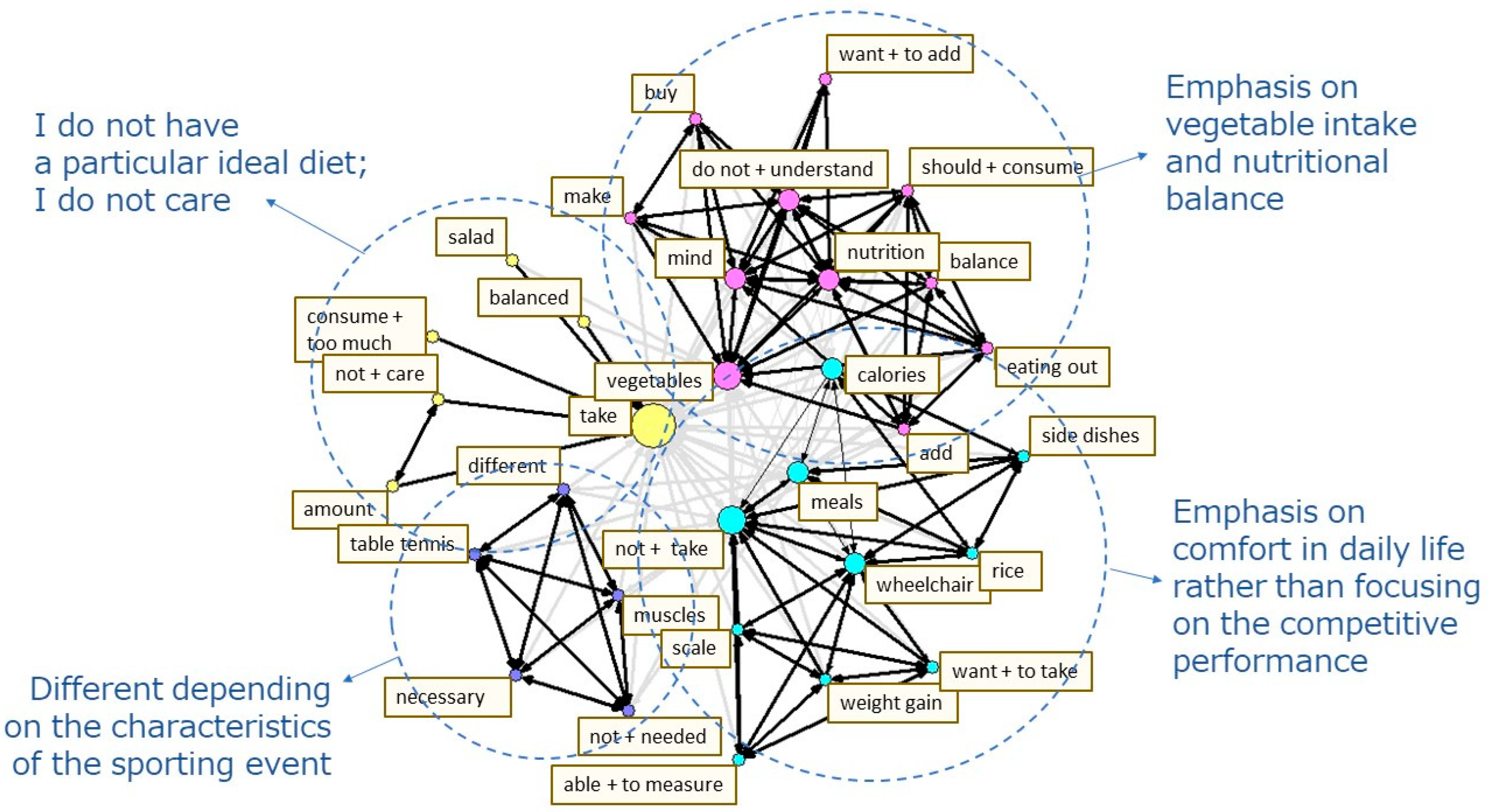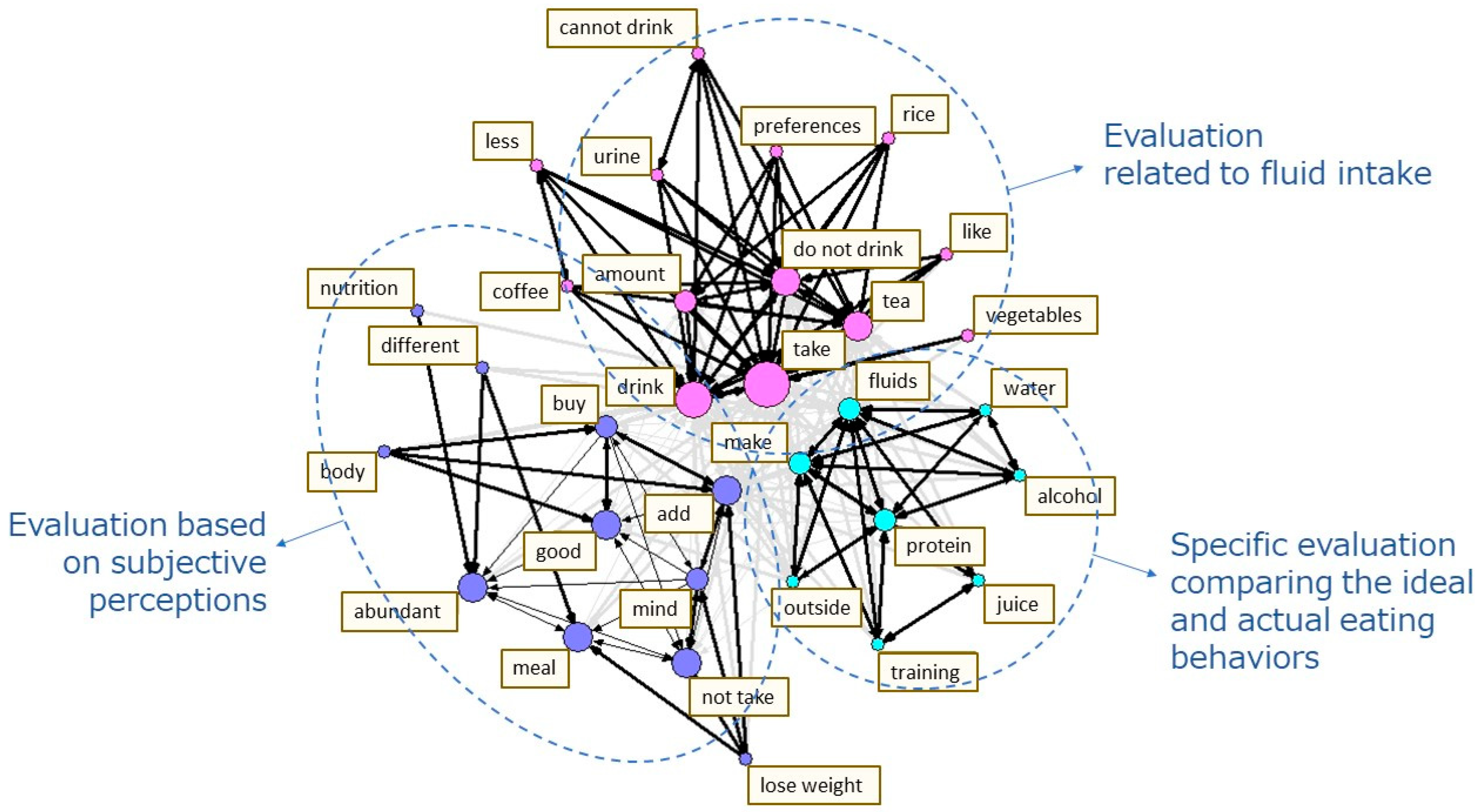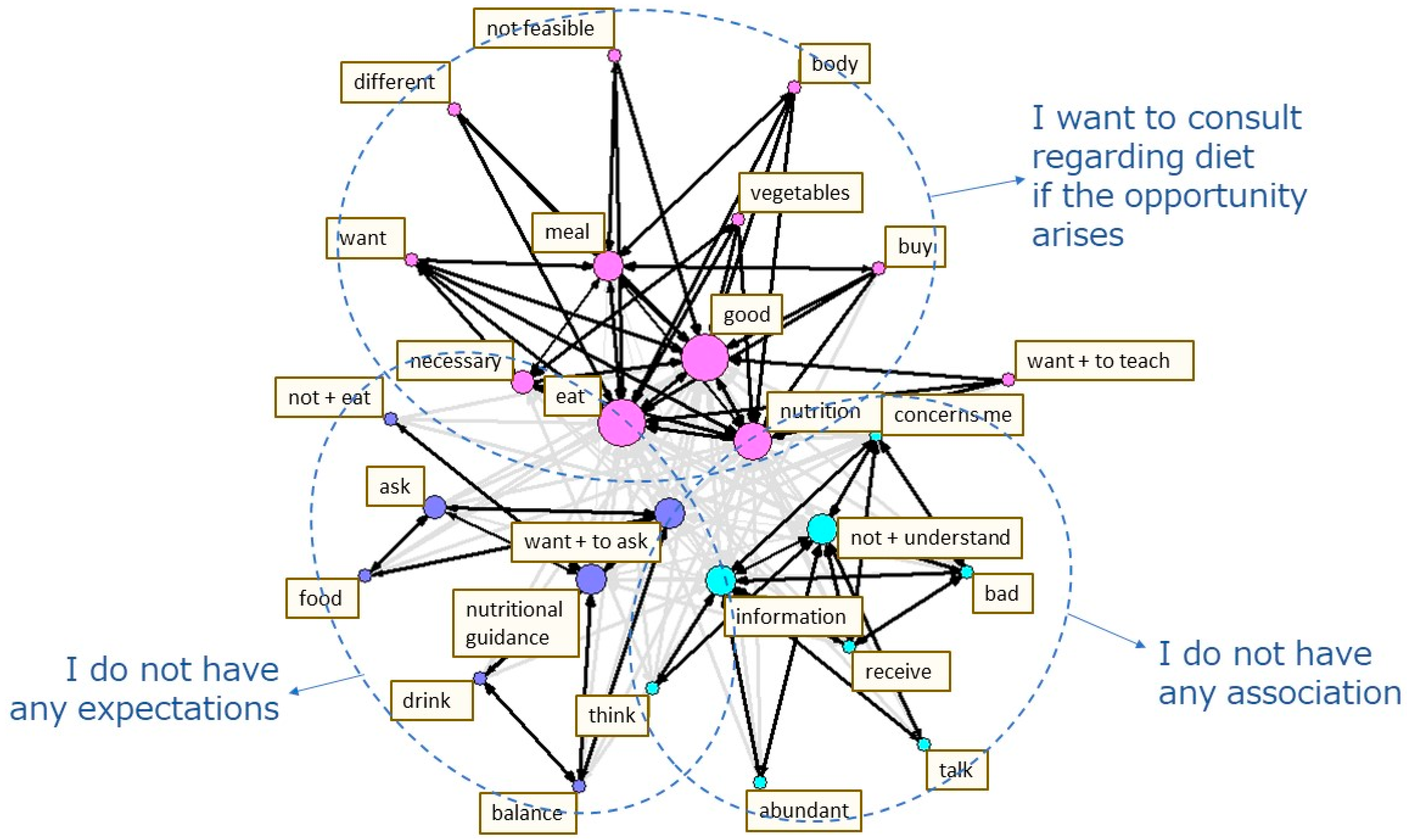The Role of Diets and Dietitians for Para-Athletes: A Pilot Study Based on Interviews
Abstract
:1. Introduction
2. Materials and Methods
2.1. Participants
2.2. Semi-Structured Interview Survey
2.3. Methods of Analysis
3. Results
3.1. Overview of the Participants
3.2. Basic Data and Frequency Analysis
3.3. Co-Occurrence Network and Categorization of Response Details
3.3.1. Interview Question (A): “What Is the Ideal Diet for Improving Competitive Performance?”
3.3.2. Interview Question (B): “How Do You Evaluate Your Typical Diet?”
3.3.3. Interview Question (C): “What Role Does the Dietician Play as Your Supporter?”
4. Discussion
5. Conclusions
Author Contributions
Funding
Institutional Review Board Statement
Informed Consent Statement
Data Availability Statement
Acknowledgments
Conflicts of Interest
References
- Third Sport Basic Plan. Available online: https://www.mext.go.jp/sports/b_menu/sports/mcatetop01/list/1372413_00001.htm (accessed on 2 May 2022).
- Second Sport Basic Plan. Available online: https://www.mext.go.jp/sports/en/b_menu/policy/sysbudget/secondsportbp.htm (accessed on 13 April 2022).
- Kinne, S.; Patrick, D.L.; Doyle, D.L. Prevalence of secondary conditions among people with disabilities. Am. J. Public Health 2004, 94, 443–445. [Google Scholar] [CrossRef]
- Jones, L.M.; Legge, M.; Goulding, A. Factor analysis of the metabolic syndrome in spinal cord-injured men. Metabolism 2004, 53, 1372–1377. [Google Scholar] [CrossRef]
- Fagher, K.; Lexell, J. Sports-related injuries in athletes with disabilities. Scand. J. Med. Sci. Sports 2014, 24, e320–e331. [Google Scholar] [CrossRef] [PubMed]
- Manore, M.M. Exercise and the Institute of Medicine recommendations for nutrition. Curr. Sports Med. Rep. 2005, 4, 193–198. [Google Scholar] [CrossRef]
- Kerksick, C.M.; Wilborn, C.D.; Roberts, M.D.; Smith-Ryan, A.; Kleiner, S.M.; Jager, R.; Collins, R.; Cooke, M.; Davis, J.N.; Galvan, E.; et al. ISSN exercise & sports nutrition review update: Research & recommendations. J. Int. Soc. Sports Nutr. 2018, 15, 38. [Google Scholar]
- Aragon, A.A.; Schoenfeld, B.J.; Wildman, R.; Kleiner, S.; VanDusseldorp, T.; Taylor, L.; Earnest, C.P.; Arciero, P.J.; Wilborn, C.; Kalman, D.S.; et al. International society of sports nutrition position stand: Diets and body composition. J. Int. Soc. Sports Nutr. 2017, 14, 16. [Google Scholar] [CrossRef]
- Purdom, T.; Kravitz, L.; Dokladny, K.; Mermier, C. Understanding the factors that effect maximal fat oxidation. J. Int. Soc. Sports Nutr. 2018, 15, 3. [Google Scholar] [CrossRef] [PubMed]
- Shirai, A.; Wadazumi, T.; Hirata, Y.; Hamada, N.; Hongu, N. Carbohydrate Mouth Rinse and Spray Improve Prolonged Exercise Performance in Recreationally Trained Male College Students. Sports 2022, 10, 51. [Google Scholar] [CrossRef]
- Manore, M.M.; Barr, S.I.; Butterfield, G.E. Position of Dietitians of Canada, the American Dietetic Association, and the American College of Sports Medicine: Nutrition and Athletic Performance. Can. J. Diet. Pract. Res. 2000, 61, 176–192. [Google Scholar]
- Smith-Ryan, A.E.; Hirsch, K.R.; Saylor, H.E.; Gould, L.M.; Blue, M.N.M. Nutritional Considerations and Strategies to Facilitate Injury Recovery and Rehabilitation. J. Athl. Train. 2020, 55, 918–930. [Google Scholar] [CrossRef]
- Burke, L.M.; Meyer, N.L.; Pearce, J. National Nutritional Programs for the 2012 London Olympic Games: A systematic approach by three different countries. Nestle Nutr. Inst. Workshop Ser. 2013, 76, 103–120. [Google Scholar]
- Hammel, J.; Magasi, S.; Heinemann, A.; Gray, D.B.; Stark, S.; Kisala, P.; Carlozzi, N.E.; Tulsky, D.; Garcia, S.F.; Hahn, E.A. Environmental barriers and supports to everyday participation: A qualitative insider perspective from people with disabilities. Arch. Phys. Med. Rehabil. 2015, 96, 578–588. [Google Scholar] [CrossRef]
- Lape, E.C.; Katz, J.N.; Losina, E.; Kerman, H.M.; Gedman, M.A.; Blauwet, C.A. Participant-Reported Benefits of Involvement in an Adaptive Sports Program: A Qualitative Study. PM R 2018, 10, 507–515. [Google Scholar] [CrossRef] [PubMed]
- International Paralympic Committee. Available online: https://www.paralympic.org/ (accessed on 21 April 2022).
- McCubbin, A.J.; Allanson, B.A.; Caldwell Odgers, J.N.; Cort, M.M.; Costa, R.J.S.; Cox, G.R.; Crawshay, S.T.; Desbrow, B.; Freney, E.G.; Gaskell, S.K.; et al. Sports Dietitians Australia Position Statement: Nutrition for Exercise in Hot Environments. Int. J. Sport Nutr. Exerc. Metab. 2020, 30, 83–98. [Google Scholar] [CrossRef] [PubMed]
- Islamoglu, A.H.; Kenger, E.B. Nutrition Considerations for Athletes with Physical Disabilities. Curr. Sports Med. Rep. 2019, 18, 270–274. [Google Scholar] [CrossRef] [PubMed]
- Broad, E. Sports Nutrition for Paralympic Athletes, 2nd ed.; CRC Press, Taylor & Francis Group: Boca Raton, FL, USA, 2019; 341p. [Google Scholar]
- Scaramella, J.; Kirihennedige, N.; Broad, E. Key Nutritional Strategies to Optimize Performance in Para Athletes. Phys. Med. Rehabil. Clin. N. Am. 2018, 29, 283–298. [Google Scholar] [CrossRef] [PubMed]
- Sports Instructors. Available online: https://www.japan-sports.or.jp/english/tabid648.html (accessed on 5 September 2022).
- Deguchi, M.; Yokoyama, H.; Hongu, N.; Watanabe, H.; Ogita, A.; Imai, D.; Suzuki, Y.; Okazaki, K. Eating Perception, Nutrition Knowledge and Body Image among Para-Athletes: Practical Challenges in Nutritional Support. Nutrients 2021, 13, 3120. [Google Scholar] [CrossRef]
- Brook, E.M.; Tenforde, A.S.; Broad, E.M.; Matzkin, E.G.; Yang, H.Y.; Collins, J.E.; Blauwet, C.A. Low energy availability, menstrual dysfunction, and impaired bone health: A survey of elite para athletes. Scand. J. Med. Sci. Sports 2019, 29, 678–685. [Google Scholar] [CrossRef]
- Pritchett, K.; Broad, E.; Scaramella, J.; Baumann, S. Hydration and Cooling Strategies for Paralympic Athletes: Applied Focus: Challenges Athletes May Face at the Upcoming Tokyo Paralympics. Curr. Nutr. Rep. 2020, 9, 137–146. [Google Scholar] [CrossRef]
- Crosland, J.A.B.C. Cerebral palsy and acquired brain injuries. In Sports Nutrition for Paralympic Athletes; Broad, E., Ed.; CRC Press: Boca Raton, FL, USA, 2014; pp. 91–105. [Google Scholar]
- Spendiff, O.; Campbell, I.G. Influence of pre-exercise glucose ingestion of two concentrations on paraplegic athletes. J. Sports Sci. 2005, 23, 21–30. [Google Scholar] [CrossRef]
- Kao, C.H.; Ho, Y.J.; Changlai, S.P.; Ding, H.J. Gastric emptying in spinal cord injury patients. Dig. Dis. Sci. 1999, 44, 1512–1515. [Google Scholar] [CrossRef] [PubMed]
- De Oliveira, E.P.; Burini, R.C. Food-dependent, exercise-induced gastrointestinal distress. J. Int. Soc. Sports Nutr. 2011, 8, 12. [Google Scholar] [CrossRef] [PubMed]
- Jonvik, K.L.; Vardardottir, B.; Broad, E. How Do We Assess Energy Availability and RED-S Risk Factors in Para Athletes? Nutrients 2022, 14, 1068. [Google Scholar] [CrossRef] [PubMed]
- Nightingale, T.E.; Walhin, J.P.; Thompson, D.; Bilzon, J.L. Influence of accelerometer type and placement on physical activity energy expenditure prediction in manual wheelchair users. PLoS ONE 2015, 10, e0126086. [Google Scholar] [CrossRef]
- Flueck, J.L.; Parnell, J.A. Protein Considerations for Athletes With a Spinal Cord Injury. Front. Nutr. 2021, 8, 652441. [Google Scholar] [CrossRef]
- Steffen, K.; Clarsen, B.; Gjelsvik, H.; Haugvad, L.; Koivisto-Mork, A.; Bahr, R.; Berge, H.M. Illness and injury among Norwegian Para athletes over five consecutive Paralympic Summer and Winter Games cycles: Prevailing high illness burden on the road from 2012 to 2020. Br. J. Sports Med. 2022, 56, 204–212. [Google Scholar] [CrossRef]
- Fine Plaza Osaka. Available online: http://www.fineplaza.jp/ (accessed on 18 April 2022).
- Osaka Para Sports Association. Available online: http://www.osad.jp (accessed on 18 April 2022).
- Mabuchi, Y.; Okawara, C.; Mendez-Ferrer, S.; Akazawa, C. Cellular Heterogeneity of Mesenchymal Stem/Stromal Cells in the Bone Marrow. Front. Cell Dev. Biol. 2021, 9, 689366. [Google Scholar] [CrossRef]
- Berry, M.W. Survey of Text Mining; Springer: New York, NY, USA, 2004. [Google Scholar]
- Position of the American Dietetic Association. Dietitians of Canada, and the American College of Sports Medicine: Nutrition and athletic performance. J. Am. Diet. Assoc. 2000, 100, 1543–1556. [Google Scholar] [CrossRef]
- Phillips, S.M. A brief review of critical processes in exercise-induced muscular hypertrophy. Sports Med. 2014, 44 (Suppl. 1), S71–S77. [Google Scholar] [CrossRef]
- Joaquim, D.P.; Juzwiak, C.R.; Winckler, C. Do paralympic track and field athletes have low energy availability? Braz. J. Kinanthropometry Hum. Perform. 2018, 20, 71–81. [Google Scholar] [CrossRef]
- Michel, J.M.; Willebois, S.; Ribinik, P.; Barrois, B.; Colin, D.; Passadori, Y. As of 2012, what are the key predictive risk factors for pressure ulcers? Developing French guidelines for clinical practice. Ann. Phys. Rehabil. Med. 2012, 55, 454–465. [Google Scholar] [CrossRef] [PubMed]
- Fuchs, C.J.; Gonzalez, J.T.; van Loon, L.J.C. Fructose co-ingestion to increase carbohydrate availability in athletes. J. Physiol. 2019, 597, 3549–3560. [Google Scholar] [CrossRef] [PubMed]
- Vandenbogaerde, T.J.; Hopkins, W.G. Effects of acute carbohydrate supplementation on endurance performance: A meta-analysis. Sports Med. 2011, 41, 773–792. [Google Scholar] [CrossRef] [PubMed]
- Manore, M.M. Energy requirements and measurement of energy expenditure. In Clinical Sports Nutrition; Burke, L., Deakin, V., Minehan, M., Eds.; McGraw Hill Education: Sydney, Australia, 2021; pp. 86–109. [Google Scholar]
- McDonald, C.M.; Abresch-Meyer, A.L.; Nelson, M.D.; Widman, L.M. Body mass index and body composition measures by dual x-ray absorptiometry in patients aged 10 to 21 years with spinal cord injury. J. Spinal Cord Med. 2007, 30 (Suppl. 1), S97–S104. [Google Scholar] [CrossRef] [PubMed]
- Price, M. Energy expenditure and metabolism during exercise in persons with a spinal cord injury. Sports Med. 2010, 40, 681–696. [Google Scholar] [CrossRef] [PubMed]
- Nightingale, T.E.; Rouse, P.C.; Thompson, D.; Bilzon, J.L.J. Measurement of Physical Activity and Energy Expenditure in Wheelchair Users: Methods, Considerations and Future Directions. Sports Med. Open. 2017, 3, 10. [Google Scholar] [CrossRef]
- Geerlings, S.E. Clinical Presentations and Epidemiology of Urinary Tract Infections. Microbiol Spectr. 2016, 4, 5. [Google Scholar] [CrossRef]
- Kim, Y.; Cho, M.H.; Do, K.; Kang, H.J.; Mok, J.J.; Kim, M.K.; Kim, G.S. Incidence and risk factors of urinary tract infections in hospitalised patients with spinal cord injury. J. Clin. Nurs. 2021, 30, 2068–2078. [Google Scholar] [CrossRef]
- Naghii, M.R. The significance of water in sport and weight control. Nutr. Health 2000, 14, 127–132. [Google Scholar] [CrossRef]
- Price, M.J.; Campbell, I.G. Effects of spinal cord lesion level upon thermoregulation during exercise in the heat. Med. Sci. Sports Exerc. 2003, 35, 1100–1107. [Google Scholar] [CrossRef] [PubMed]
- Eskici, G.; Ersoy, G. An evaluation of wheelchair basketball players’ nutritional status and nutritional knowledge levels. J. Sports Med. Phys. Fit. 2016, 56, 259–268. [Google Scholar]
- Berner, P.; Bezner, J.R.; Morris, D.; Lein, D.H. Nutrition in Physical Therapist Practice: Tools and Strategies to Act Now. Phys. Ther. 2021, 101, pzab061. [Google Scholar] [CrossRef] [PubMed]




| No. | Age (Years) | Gender | Event | Experience in Sport (Years) | Primary Disabilities | Ranking, etc. |
|---|---|---|---|---|---|---|
| 1 | 44 | F | Wheelchair tennis | 20 | Spinal cord injury | Japan Wheelchair Tennis Association Wheelchair tennis ranking 19th place (Women’s Singles, 2020) |
| 2 | 37 | M | Wheelchair softball (Class 3) | 2 | Spina bifida | Member of a team in the Japanese wheelchair softball league Experience in baseball for people with physical disabilities: 19 years Experience in wheelchair marathon: 4 years |
| 3 | 45 | M | Wheelchair softball (Class 3) | 4 | Spina bifida | Member of a team in the Japanese wheelchair softball league (Representative of the Japanese team in 2020) Experience in baseball for people with physical disabilities: 14 years Experience in wheelchair tennis: 4 years |
| 4 | 32 | M | Wheelchair softball (Class 2) | 2 | Spinal cord injury | Member of a team in the Japanese wheelchair softball league (Representative of the Japanese team in 2020) Experience in wheelchair basketball: 3 years |
| 5 | 70 | F | Wheelchair table tennis (Class 5) | 26 | Sacral tumor | Represented Japanese team in the Athens, Beijing, London, and Rio de Janeiro paralympic games |
| 6 | 30 | M | Wheelchair table tennis (Class 5) | 9 | Severe thermal trauma | 2019 Japan Open Para Table Tennis Championship Individual gold medal, representative of the Japanese team in 2019 World ranking 35th place |
| 7 | 30 | F | Boccia (Physical Therapist) | --- | Able-bodied | Boccia International Referee Japan Boccia Association Referee at Grade SA |
| Item | Value | ||
|---|---|---|---|
| (A) | (B) | (C) | |
| What is the ideal diet for improving competitive performance? | How do you evaluate your typical diet? | What role does the dietician play as your supporter? | |
| Total number of responses | 7 | 7 | 7 |
| Mean character count per response | 641 | 1225 | 1184 |
| Total number of sentences | 149 | 311 | 228 |
| Mean character count per sentence | 30 | 28 | 36 |
| Total number of terms | 871 | 1675 | 1596 |
| Number by term category | 427 | 7 | 673 |
| (A) | (B) | (C) | ||||
|---|---|---|---|---|---|---|
| What Is the Ideal Diet for Improving Competitive Performance? | How Do You Evaluate Your Typical Diet? | What Role Does the Dietician Play as Your Supporter? | ||||
| Term | Number of Occurrences | Term | Number of Occurrences | Term | Number of Occurrences | |
| Most frequent  | Consume | 6 | To consume | 7 | To consume | 7 |
| Not + consume | 4 | To drink | 6 | Good | 7 | |
| Vegetables | 4 | Team | 5 | Nutrition | 6 | |
| Good | 4 | Not + drink | 5 | Nutritional guidance | 5 | |
| Calories | 3 | Meal | 5 | Information | 5 | |
| Nutrition | 3 | Not + consume | 5 | Meals | 5 | |
| Mind | 3 | Abundant | 5 | Not + understand | 5 | |
| Like | 3 | Add | 5 | Want + to ask | 5 | |
| Wheelchair | 3 | Good | 5 | Image | 4 | |
| Meal | 3 | Protein | 4 | Necessary | 4 | |
| Not + know | 3 | Mind | 4 | Ask | 4 | |
| Not + good | 3 | Make | 4 | No + imagine | 3 | |
| Side dishes | 2 | Water | 4 | Balance | 3 | |
| Rice | 2 | Buy | 4 | Bad | 3 | |
| Salad | 2 | Amount | 4 | Different | 3 | |
| Balance | 2 | Alcohol | 3 | To drink | 3 | |
| Different | 2 | Coffee | 3 | Am concerned | 3 | |
| Eating out | 2 | Rice | 3 | Want + to teach | 3 | |
| Don’t care | 2 | Juice | 3 | To think | 3 | |
| Muscles | 2 | Training | 3 | To receive | 3 | |
| Categories | Subcategories | Examples of Responses That Contained Words inside the Clusters |
|---|---|---|
| Importance of maintaining physical strength and concentration during matches |
|
| Vegetables should be eaten |
|
| It is important to have a balanced diet |
| |
| Weight gain also impairs daily living |
|
| I do not know what the ideal diet is |
|
| I have no ideals |
|
| Categories | Subcategories | Examples of Responses That Contained Words inside the Clusters |
|---|---|---|
| I am consuming adequate water |
|
| I drink less than the optimal amount of water |
| |
| I am supplementing the necessary nutrients |
|
| I do not eat breakfast |
| |
| My physical condition is good |
|
| I am able to minimize food intake |
| |
| I feel that my dietary intake is higher than the ideal amount |
|
| Categories | Subcategories | Examples of Responses That Contained Words inside the Clusters |
|---|---|---|
| I want to learn and expand my knowledge on nutrition |
|
| I want my diet to be managed |
| |
| I do not think I need nutritional guidance on a daily basis |
|
| I do not know how to get acquainted |
| |
| I would not be able to put whatever I learn into practice |
|
Publisher’s Note: MDPI stays neutral with regard to jurisdictional claims in published maps and institutional affiliations. |
© 2022 by the authors. Licensee MDPI, Basel, Switzerland. This article is an open access article distributed under the terms and conditions of the Creative Commons Attribution (CC BY) license (https://creativecommons.org/licenses/by/4.0/).
Share and Cite
Yokoyama, H.; Deguchi, M.; Hongu, N. The Role of Diets and Dietitians for Para-Athletes: A Pilot Study Based on Interviews. Nutrients 2022, 14, 3720. https://doi.org/10.3390/nu14183720
Yokoyama H, Deguchi M, Hongu N. The Role of Diets and Dietitians for Para-Athletes: A Pilot Study Based on Interviews. Nutrients. 2022; 14(18):3720. https://doi.org/10.3390/nu14183720
Chicago/Turabian StyleYokoyama, Hisayo, Miwako Deguchi, and Nobuko Hongu. 2022. "The Role of Diets and Dietitians for Para-Athletes: A Pilot Study Based on Interviews" Nutrients 14, no. 18: 3720. https://doi.org/10.3390/nu14183720
APA StyleYokoyama, H., Deguchi, M., & Hongu, N. (2022). The Role of Diets and Dietitians for Para-Athletes: A Pilot Study Based on Interviews. Nutrients, 14(18), 3720. https://doi.org/10.3390/nu14183720






